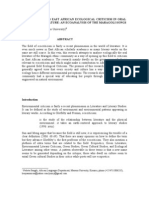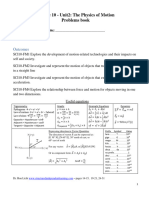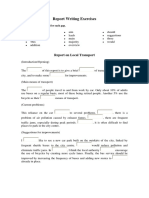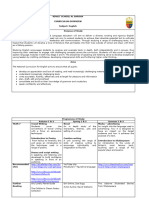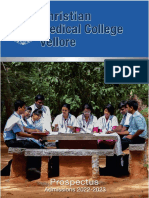1 PB
1 PB
Uploaded by
Ayca UgurluCopyright:
Available Formats
1 PB
1 PB
Uploaded by
Ayca UgurluOriginal Title
Copyright
Available Formats
Share this document
Did you find this document useful?
Is this content inappropriate?
Copyright:
Available Formats
1 PB
1 PB
Uploaded by
Ayca UgurluCopyright:
Available Formats
http://elr.sciedupress.com English Linguistics Research Vol. 7, No.
4; 2018
Interface of the Environment and Characters
in Adichie’s Purple Hibiscus
Dr. Mrs Angela Ngozi Dick1
1
Department of English and Literary Studies, Veritas University Abuja, Nigeria
Correspondence: Dr. Mrs Angela Ngozi Dick, Department of English and Literary Studies, Veritas University Abuja,
Nigeria
Received: October 30, 2018 Accepted: December 6, 2018 Online Published: December 17, 2018
doi:10.5430/elr.v7n4p31 URL: https://doi.org/10.5430/elr.v7n4p31
Abstract
The focus of this paper exposed the engagement of the literary persons in Adichie’s Purple Hibiscus and its
environment. How the characters interfaced with their environment to develop the plot is examined. The
environment refers to the natural world as a whole or a particular geographical area, especially as affected by human
activity. It can also refer to all circumstances, people, events, living or non-living things, physical or chemical
processes, and natural forces. In Purple Hibiscus, the environment operationally refers to the cities and villages,
flower gardens and insects, football field, the church, cultural and religious practices, the characters that people
(inhabit) the setting of the novel. All these form the setting and influence the actions and behaviour of the characters.
Eco-criticism as a literary theory best explains the relationship between literature and the environment. It interpretes
the actions of the characters based on their surroundings. This literary exercise used a branch of eco-criticism that
studies the relationship between literature and the physical environment to analyze Adichie’s Purple Hibiscus.
Keywords: characters, environment, interface
1. Introduction
Characters refer to the people that inhabit a literary work. Depending on the author’s point of view, animals could be
used symbolically to represent characters. Setting refers to the contrived world which the characters live in,
interacting with one another in a literary text. In Purple Hibiscus, the characters are affected by the plants and
seasons. This engagement of the environment and characters in the plot of this novel attracts eco-criticism to its
analysis.
Cheryll Glotfelty is the father of eco-criticism in the United States of America while Jonathan Bate is considered the
founder in England. Eco-criticism emerged in the 1980s because of environmental degradation. However,
environmental movement began in the 1960s with the publication of Rachael Carson’s work entitled Silent Spring.
Eco-criticism also deals with reality itself and how human culture is connected to the physical world, affecting it and
is affected by it (OWL.purdue2018). In the United Kingdom eco-criticism is referred to as Green Studies and its
emphasis is on violence in the environment, especially how urbanization causes pollution and poverty. In the United
States of America it is called eco-criticism and the emphasis is to celebrate nature (OWL.purdue2018) and it shows
how useful it is writing about nature. The definition by Bertens (2008) states that: “eco-criticism examines
representations of nature in literary texts, films, televisions, etc (p.200)”.
There other terms identified with eco-criticism: pastoral deals with the difference between urban and rural life;
wilderness discusses the engagement of wilderness in literature. Mention must be made of eco-feminism which is a
branch of this theory that looks at nature, women, other oppressed groups, races and their interaction with dominant
power. There is also eco-grief that looks at environmental toxins that cause cancer and other diseases in the human
body.
There are three main settings in Purple Hibiscus: Enugu, Abba and Nsukka all in present day Enugu State of
Nigeria. To the character of Eugene Achike, Enugu and Abba are very important. Nevertheless, Nsukka
counterpoises Enugu and Abba to enable the story teller compare the two families prominent in the novel. The
narrator’s family operates between Enugu and Abba ostensibly determined and conditioned by the harmattan and
Christmas season. The head of this family is called Eugene Achike whose religious piety dehumanizes members of
Published by Sciedu Press 31 ISSN 1927-6028 E-ISSN 1927-6036
http://elr.sciedupress.com English Linguistics Research Vol. 7, No. 4; 2018
his nuclear and extended families. Eugene’s religious piety is contrasted with that of his younger sister Aunty Ifeoma,
married also into a Catholic family resident at Nsukka. Aunty Ifeoma practises her religion with human freedom, joy
and laughter. These two family heads are polarized on religious observances, underpinning the difference between a
female headed-household and the normal or male-headed household. Mention must be made that Aunty Ifeoma is a
widow saddled with the upbringing of three children with a meagre wage as a lecturer in the University of Nigeria,
Nsukka.
2. Enugu Garden and Intimate Violence
The reader perceives the engagement of the environment in the actions of the characters. For example, when the plot
of Purple Hibiscus is “sutured” it will be observed that the conflict began after the brief holiday in Aunty Ifeoma’s
house at Nsukka with the following engagement of nature in the plot. Disharmony in the family is configured thus:
Everything came tumbling down after Palm Sunday. Howling winds came with an angry rain, uprooting
frangipani trees in the front yard. They lay on the lawn, their pink and white flowers grazing the grass, their
roots waving lumpy soil in the air. The satellite dish on top of the garage came crashing down, lounged on
driveway like a visiting alien spaceship. The door of my wardrobe dislodged completely. Sisi broke a full set
of Mama’s china (p. 261).
This introduces the vehemence with which Jaja rejects Holy Communion on Palm Sunday. He acts on hurts and
wounds precipitated by his father’s religious practices, a rejection of what Eugene Achike stands for, his
uncompromising principles and his conviction to go to heaven after death. When compared with Aunty Ifeoma and
Fr Amadi, Eugene and Fr Benedict, Jaja finds deception in what his father and Fr Benedict practice. Rejecting Holy
Communion is a negation of his father’s religious stance, an interrogation of every decision and action of Eugene
Achike especially his repudiation of Papa Nnukwu, his refusal to assist Aunty Ifeoma financially. The schedule that
regiments family life, incessant battering of his wife even during pregnancy emotionally deplete his children.
Eugene’s style of parenting deserves attention here. A parent promotes emotional, physical, intellectual, and social
development of his children. Eugene is lacking in providing emotional support for his children. His wife is forced
into passivity being punished the same way her children are punished. When Kambili eats cornflakes to aid
medication for menstrual cramp ten minutes before Holy Mass, the punishment is for everyone. The narrator states:
“[Eugene] unbuckled his belt slowly . . . It landed on Jaja first, across his shoulder. Then Mama raised her hands as it
landed on her upper arm. I put the bowl down just as the belt landed on my back” (p.110). This qualifies as intimate
violence when family relationship is riddled with “pronounced tension, driving people to despair or filling them with
a deep sense of anxiety or guilt ”(Giddens 2008 p.219). He practices authoritarian parenting.
Eugene falls into the refuge of religious fanaticism by wholly identifying with Fr Benedict who does not find merit in
the culture of his parishioners. Having been formed by Catholic piety and Fr Benedict’s austere Christianity,
everything Eugene does is marked by extremism. Nevertheless this finds expression in the environment within his
Enugu residence where the hibiscus plant in his garden is scarlet. The buzzing bees attracted to the yellow cashew
fruits reflect how busy and regimented his life is. The bees are busy creatures symbolizing his success in business
with factories that manufacture fruit juice, wafer and biscuits. His success in business does not ensure a happy family.
The scarlet hibiscus flowers denote emotional strain and overwhelming trauma on his family. But the buzzing bees at
Nsukka garden lull Kambili to sleep. He is also a media owner of The Standard Newspaper with a retinue of
domestic servants and factory staff. His family life is regimented around culinary timetable, children’s academic life,
family time during which newspaper commentary is discussed. His children are Jaja and Kambili. Their activities are
defined by studying, washing their school uniforms or playing chess indoors. They are not seen playing outdoors.
They speak in whispers bereft of humour, laughter or songs (Purple Hibiscus pp.132&176). In an earlier work, Dick
(2009), blames this restricted type of life on “religious fanaticism overtly succured by the unrestrained praises by the
British Father Benedict” (p.100).
Their life is structured on schedule placed on the wall above their beds in their respective rooms. The schedule or
timetable sets him as strict and authoritarian. This schedule was taken to Nsukka when they went on Christmas
holidays at Aunty Ifeoma’s house. However, Aunty Ifeoma overrules the use of that schedule in her own house
(Purple Hibiscus p.132). Enugu garden stands out as chaotic like trauma that never heals. This is echoed by Jaja
when he states that the shock felt by Ade Coker’s daughter after the bomb blast that rips Ade Coker open will never
heal: “She will never heal, Jaja said. She may have started talking now, but she will never heal” (p.263). For Jaja, his
mother has endured enough pain, seeing her go with the police is unbearable, so he pleads guilty, swapping prison
terms with his mother ( p.295).
Published by Sciedu Press 32 ISSN 1927-6028 E-ISSN 1927-6036
http://elr.sciedupress.com English Linguistics Research Vol. 7, No. 4; 2018
There is a catalogue of human suffering. Jaja’s finger is charred, he batters his wife resulting to numerous
miscarriages, Kambili is hospitalized after a brutal beating for preserving the painting of Papa Nnukwu. “Still air,
slowly rousing itself after the rain, clouds like cotton wool tufts announced the arrival of Mama after Eugene broke a
small prayer table on her stomach causing another miscarriage (p. 252 )”. Ade Coker is murdered in the middle of
parched harmattan, on a day it rained heavily (p.212).
3. Nsukka Garden and Family Life
Aunty Ifeoma is portrayed as an exuberant, hilarious woman with loud laughter that echoes for a while (p.100). The
purple hibiscus flower adds grace and candour to her poor residence. Her garden at University of Nigeria Nsukka is a
circular burst of bright colours, budding hybrid hibiscus plant that blossoms purple flowers. Other plants include
ixora, roses, lilies, croton growing side by side like a painted wreath (p.120) replicated in her affectionate reception
of Jaja and Kambili. The narrator states: “She barely waited for us to climb out of the car before hugging us,
squeezzing us close together so we both fit in the stretch of her arms (p.121).”The flowers in her garden show her as
more ecumenical and accommodating than her brother Eugene Achike. Eugene’s flowers are plucked to decorate the
alter in St Agnes’s Catholic Church Enugu only, while the flowers in Aunty Ifeoma’s house are plucked by women
from both Catholic and Anglican communion to decorate their church alters. Life in Aunty Ifeoma’s house is not
regimented. Morning and night prayers are interspersed with native Christian songs and ended with prayer to find
laughter in their daily interactions.
Moreover, the spirit of African community life finds expression here making generation gap as elastic as possible.
Their grandfather, Papa Nnukwu, is accommodated in Ifeoma’s family, celebrated and desired. He tells them
folktales, they cook native delicacy (ofe nsala) and take turns to watch him when he sits in the verandah (p.173).
Adichie casts Nsukka garden as a landscape of moral harmonious order that houses Aunty and her children
contrasting it with the chaotic garden at Enugu. This section will be concluded by stating that Aunty Ifeoma is a
humanizing presence.
4. Kambili Speaks Again
The process of emotional, physical and spiritual healing of Kambili begins in Nsukka the day she “watched a wilted
African lily fall from its talk in the garden. The crotons rustled in the late morning breeze” (p.177). Her interaction
with Aunty Ifeoma’s children, other boys in the stadium coordinated through Fr Amadi’s pastoral functions gives
voice to a speechless Kambili. She concludes that she is no longer confined or in captivity. Now imbued with a new
personality she states; “I had smiled, run, laughed. My chest was filled with something like bath foam. Light. The
lightness was so sweet I tasted it on my tongue, the sweetness of an overripe bright yellow cashew fruit (p.187)”.
Also, Jaja becomes a new personality by working with Obiora on the garden, fetching water, washing Aunty
Ifeoma’s car and other chores. Obiora is protective of his mum and Jaja likes it. This prompts him to appropriate
his mother’s crime swapping detention in prison.
Jaja and Kambili’s actions have been couched in whispers, and silence for fear of Eugene and hell fire. They were
regulated by religious piety of Fr Benedict. But the pastoral activities of Fr Amadi negated the pastoral piety of Fr
Benedict resulting in courage, self confidence and new individuality. As Fr Amadi announces his posting to
Germany, Amaka tells him:
The white missionaries brought us their god. . . .Which was the same colour as them, worshipped in their
language and packaged in the boxes they made. Now that we take their god back to them, shouldn’t we at
least repackage it (p.271)?
It is cheering to see a new woman making up though unsuccessfully in shorts dashing out to stadium for sports.
5. The Elements and Eugene’s Philantropy
The elements refer to strong winds, heavy rain or other conditions of bad weather. It seems that the elements
underpin Eugene’s philanthropic stance as the following excerpts highlight:
Dust-laden winds of the harmattan came with December. They brought the scent of the Sahara and Christmas,
yanked the slender, ovate leaves down from the frangipani and the needle-like leaves from the whistling pines,
covering everything in a film of brown . . . .
The morning winds were swift on the day we left, pushing the whistling pine trees so that they are bent and
twisted, as if bowing to a dusty god . . . (p. 61).
Harmattan launches the Christmas season in Igboland of Nigeria. December and Christmas mark the exodus of Igbo
in diaspora/cities to the villages for re-union, community life, and kinship socialization. Therefore the setting shifts
Published by Sciedu Press 33 ISSN 1927-6028 E-ISSN 1927-6036
http://elr.sciedupress.com English Linguistics Research Vol. 7, No. 4; 2018
to Abba. At Ninth Mile, Eugene buys okpa, distributes money to the women from whom he does not buy (p.61).
Moreover, the half naked boys acclaim his traditional title Omelora, One Who Does for the Community. He gives
them money instructing them to show the money to their parents (p.63) thus portraying his strictness. Because of
the season, the characters become more human, the plot acquires greater verisimilitude. His compound at Abba is
outsized. The reader beholds the wealth of Eugene Achike: four storey building, food, drinks for hosting church
council meeting, town council meeting and to lodge numerous visitors, friends and relatives. Pots big enough to
contain whole goats accentuate Eugene’s title. The presence of the wives of the umunna cooking, eating, drinking
and visits of villagers, fellow feelings show kinship socialization. Beatrice/Mama and her children become affable
and relaxed unlike the regimented life at Enugu. However, he ostracizes his father and other traditionalist, excluding
them from his charity. Waste is also depicted because nobody inhabits this mansion throughout the year except at
Christmas period (p.66).
Abba makes the characters more human as the action of characters is prodded by their environment. The rustling of
coconut fronds, bleating goats, crowing cocks signal daybreak. People yell greetings to one another across mud
compound walls to depict community life and attendant joy of Christmas period (p.66). Usually harvest is over and
people are at home in preparation for next planting season. The religious barrier between Eugene and his father,
Papa Nnukwu is reviewed through flashback. The role of the male elders in conflict resolution becomes evident;
Papa Nnukwu is portrayed as a strongman with incredible faith in his traditional religion, which cannot be shaken by
Eugene’s wealth. The religious barrier is couched in irony of quality of residence:
Eugene lives in an imposing four storey building, with glaring white walls, silver coloured water fountain
while Papa Nnuku’s house has small unpainted cement blocks compact like dice, with creaking wooden gate
and a veranda bounded by rusty metal bars. His food placed on a raffia mat as he sat on a low stool a
white . . . his singlet browned by age and yellow at the armpit, walking stick fashioned from a crooked tree
branch (pp. 70-75).
6. Traditional Religion and the Tragedy of Eugene
The prominence an event gains during narration is projected by the action of the environment, invading the setting
with what science and technology calls superstition. Papa Nnukwu’s chi pervades the world view of the setting and is
in constant interaction with the characters. One of the tenets of African Traditional Religion is reincarnation which is
the belief in the cyclic nature of life. Cayce refers to it as “the continuity life” (edgarcayce.org). Through Papa
Nnukwu, it is revealed that Jaja is Ogbuefi Olioke come back. Ogbuefi Olioke is Papa Nnukwu’s father. He prays to
his chi for great prospects for his children and grand children and died smiling to his chi. Eugene prays for the
conversion of his father without adequate welfare. Ironically he dies from poison prepared by his wife and his
housemaid.
The premonition of his death is taken over by the elements:
Outside, the rain came down in slants, hitting the closed window with a furious rhythm. It would hurl down
cashews and mangoes from the trees they would start to rot in the humid earth, giving out the sweet-and-sour
scent(Purple Hibiscus p. 292).
His condition is as tragic as Achebe’s Okonkwo in Things Fall Apart whose commitment to his culture leads him to
commit murder and ultimately suicide. An alien government more powerful and brutal overwhelms Umuofia. Fr
Benedicts wields an overwhelming power over Eugene. Eugene’s commitment to his faith and Fr Benedict alienates
him from his wife, children, sister, father and other kins. He fails to navigate between family relationships and the
fear of hell just like Okonkwo is afraid of being thought weak. He is killed by the herbs prepared by his housemaid’s
uncle. His death signals a new social ascendancy for his family who plan to travel to the United States of America to
re-unite with Aunty Ifeoma and her children. His funeral obsequies do not complement his opulence in life. Papa
Nnukwu fares better in this. Papa Nnukwu’s funeral is celebrated with seven cows amidst traditional rites. He is
buried as he professed. Eugene dies, his family survives him, happy and harmonious but without funeral rites.
7. Conclusion
This paper has discussed the interaction of the characters and the environment in Adichie’s Purple Hibiscus. The
environment refers to the surroundings of living organisms. It includes human beings, animals, plants, insects, the
seasons, etc. Eco-criticism is a literary theory that interrogates how the environment is engaged in literature. Cheryll
Glotfelty is the father of eco-criticism in the United States of America while Jonathan Bate is considered the founder
in England. The scarlet hibiscus and buzzing bees at Enugu garden represent regimented life of Eugene and his
family while the purple hibiscus at Nsukka portrays intimacy and laughter felt in Aunty Ifeoma’s family. The
Published by Sciedu Press 34 ISSN 1927-6028 E-ISSN 1927-6036
http://elr.sciedupress.com English Linguistics Research Vol. 7, No. 4; 2018
buzzing bees in Nsukka garden lull Kambili to sleep but circumscribe Kambili’s growth at Enugu and Abba. The
harmattan shifts the setting from Enugu to Abba thus portraying the strained relationship between Eugene and his
father, and his ambivalent philanthropic stance. The interaction of characters and the garden at Nsukka produce new
personalities in Kambili and Jaja. Eugene’s death is not mourned on the contrary his death serves to produce a
happier Achike family. The environment is always a premonition to what a character will do or what will befall a
character. The environment therefore shapes characters.
References
Achebe, C. Things fall apart. (1974). London: Heinemann.
Anusiem-Dick, (May 2009). Gender, family cohesion, the African family and religios fanaticism in Adichie’s purple
hibiscus. Currents in African literature and the English language. Calabar: University of Calabar.vi . pp.98-109.
Bertens, Hans. (2008). Literary theory: The basics. London: Taylor & Francis.
Cayce, E. “God’s other and the continuity life”. /edgarcayce.org/ accessed 25 th October, 2018.
Giddens, A. (2008). Sociology 5th edition. Cambridge: Polity Press.
Published by Sciedu Press 35 ISSN 1927-6028 E-ISSN 1927-6036
You might also like
- First Knowledges Plants: Past, Present and FutureFrom EverandFirst Knowledges Plants: Past, Present and FutureRating: 4.5 out of 5 stars4.5/5 (2)
- Science by the People: Participation, Power, and the Politics of Environmental KnowledgeFrom EverandScience by the People: Participation, Power, and the Politics of Environmental KnowledgeNo ratings yet
- Msc. Holistic Science: Schumacher College: Embodying GaiaDocument10 pagesMsc. Holistic Science: Schumacher College: Embodying GaiamegandebeyerNo ratings yet
- Oikos: God’s Big Word for a Small Planet: A Theology of Economy, Ecology, and EcumenyFrom EverandOikos: God’s Big Word for a Small Planet: A Theology of Economy, Ecology, and EcumenyNo ratings yet
- An Ecocritical ReadingDocument8 pagesAn Ecocritical ReadingAkpevweOghene PeaceNo ratings yet
- Ecological Migrants: The Relocation of China's Ewenki Reindeer HerdersFrom EverandEcological Migrants: The Relocation of China's Ewenki Reindeer HerdersNo ratings yet
- The Land Is Dying: Contingency, Creativity and Conflict in Western KenyaFrom EverandThe Land Is Dying: Contingency, Creativity and Conflict in Western KenyaNo ratings yet
- Thomas Berry: On Our Broken Connection To The Natural WorldDocument4 pagesThomas Berry: On Our Broken Connection To The Natural WorldAnonymous KMVhQx5i3nNo ratings yet
- Expository Essay About MusicDocument5 pagesExpository Essay About Musickbmbwubaf100% (2)
- .MY ECOcritical WorkDocument7 pages.MY ECOcritical WorkJOSYNo ratings yet
- Maragooli SongsDocument17 pagesMaragooli SongsDestiny HawkNo ratings yet
- 11 Indigenous authorsDocument4 pages11 Indigenous authorshenrique.severusNo ratings yet
- When the Wild Comes Leaping Up: Personal encounters with natureFrom EverandWhen the Wild Comes Leaping Up: Personal encounters with natureRating: 3 out of 5 stars3/5 (3)
- The Environment and Social Work-InspirationDocument9 pagesThe Environment and Social Work-Inspirationapi-281339822No ratings yet
- Eshun Edwin K 201106 MaDocument61 pagesEshun Edwin K 201106 MaRandy1313No ratings yet
- 2347-Article Text-5394-1-10-20170211Document17 pages2347-Article Text-5394-1-10-20170211cygratecNo ratings yet
- Attunements for the Earth: Poetic Musical Photographic Anecdotal Climatic Intuitional Scientific SpiritualFrom EverandAttunements for the Earth: Poetic Musical Photographic Anecdotal Climatic Intuitional Scientific SpiritualNo ratings yet
- Luquin Mangyan Patag House-HALDocument24 pagesLuquin Mangyan Patag House-HALAgatha AgatonNo ratings yet
- Nature Strange and Beautiful: How Living Beings Evolved and Made the Earth a HomeFrom EverandNature Strange and Beautiful: How Living Beings Evolved and Made the Earth a HomeNo ratings yet
- Japonezi NumeleDocument8 pagesJaponezi NumeleEduard StoicaNo ratings yet
- The Theme of Superstitions in Chinua Achebes Things Fall ApartDocument2 pagesThe Theme of Superstitions in Chinua Achebes Things Fall ApartEnglish Crew88% (8)
- Reading For Journal WritingDocument4 pagesReading For Journal WritingRAPIDAH BINTI OMAR KPM-GuruNo ratings yet
- An Eco-Feminist Reading of Chinua Achebe's Things FallDocument16 pagesAn Eco-Feminist Reading of Chinua Achebe's Things FallTamsa PandyaNo ratings yet
- Development Team: Paper No.: 02 Social Cultural Anthropology Module: 09 Approaches To The Study of FamilyDocument13 pagesDevelopment Team: Paper No.: 02 Social Cultural Anthropology Module: 09 Approaches To The Study of FamilyBanu SreeNo ratings yet
- 6395-Article Text-24837-1-10-20230520Document6 pages6395-Article Text-24837-1-10-20230520mimNo ratings yet
- Taylor Religion31Document21 pagesTaylor Religion31Fysh WongNo ratings yet
- Albrecht - SolastalgiaDocument15 pagesAlbrecht - SolastalgiaLajos HorváthNo ratings yet
- The Songs of Trees: Stories from Nature's Great ConnectorsFrom EverandThe Songs of Trees: Stories from Nature's Great ConnectorsRating: 3.5 out of 5 stars3.5/5 (38)
- Solastalgia' A New Concept in Health and IdentityDocument15 pagesSolastalgia' A New Concept in Health and IdentityManuel Franco AvellanedaNo ratings yet
- Ghostsin Chineseand Igbo Religion 1Document18 pagesGhostsin Chineseand Igbo Religion 1Khyati ParasharNo ratings yet
- 4 M-Marimuthu December-2016 Ad-LitteramDocument11 pages4 M-Marimuthu December-2016 Ad-Litteramninosaptenno15No ratings yet
- A Sculptural Representation of Traditional' Marriage (Igba Nkwu) in Ichida Town, Anambra StateDocument14 pagesA Sculptural Representation of Traditional' Marriage (Igba Nkwu) in Ichida Town, Anambra Statekumarsourav0417No ratings yet
- Cebuano Sorcery Richard W. Lieban download pdfDocument84 pagesCebuano Sorcery Richard W. Lieban download pdfakemurihame100% (6)
- Interview PaperDocument7 pagesInterview Paperapi-686107418No ratings yet
- Donna Birdwell-Pheasant (Editor), Denise Lawrence-Züniga (Editor) - House Life - Space, Place and Family in Europe-Routledge (Berg Publishers) (1999) PDFDocument280 pagesDonna Birdwell-Pheasant (Editor), Denise Lawrence-Züniga (Editor) - House Life - Space, Place and Family in Europe-Routledge (Berg Publishers) (1999) PDFFabiola MoroniNo ratings yet
- Collected Papers of Michael E. Soulé: Early Years in Modern Conservation BiologyFrom EverandCollected Papers of Michael E. Soulé: Early Years in Modern Conservation BiologyNo ratings yet
- ScheperHughes1985 Culture Scarcity and Maternal ThinkingDocument28 pagesScheperHughes1985 Culture Scarcity and Maternal ThinkingGiovanna CapponiNo ratings yet
- The Island of Enlightenment - An Eco Critical Analysis of Hayy Ibn YaqzanDocument16 pagesThe Island of Enlightenment - An Eco Critical Analysis of Hayy Ibn YaqzanLevent BerkayNo ratings yet
- Research Paper On Rachel CarsonDocument8 pagesResearch Paper On Rachel Carsonhyzypif0gif3100% (1)
- Nature Vs Nurture EssayDocument8 pagesNature Vs Nurture Essayd3h7qfpr100% (2)
- Emotions in AnthropologyDocument205 pagesEmotions in AnthropologySil SectNo ratings yet
- American Indian Ideologies in the Round HouseDocument17 pagesAmerican Indian Ideologies in the Round HouseEd WilcoxNo ratings yet
- 17.Applied-A Study of Zu - Local Rice Beer - Amongst - NANCY C MALSAWMTLUANGIDocument8 pages17.Applied-A Study of Zu - Local Rice Beer - Amongst - NANCY C MALSAWMTLUANGIImpact JournalsNo ratings yet
- Brain Drain in India EssayDocument8 pagesBrain Drain in India Essayhqovwpaeg100% (2)
- AS Unit 1 Acquiring CultureDocument18 pagesAS Unit 1 Acquiring CultureAgnis Dwi Ratna PuspitasariNo ratings yet
- The Ecologist - Life, Religion and EverythingDocument6 pagesThe Ecologist - Life, Religion and EverythingwilhelmclimbNo ratings yet
- Ingles Semana 4 BachilleratoDocument4 pagesIngles Semana 4 BachilleratoRafael CoronelNo ratings yet
- Landscape, Process and Power: Re-evaluating Traditional Environmental KnowledgeFrom EverandLandscape, Process and Power: Re-evaluating Traditional Environmental KnowledgeSerena HecklerNo ratings yet
- 157917-Article Text-411175-1-10-20170621Document10 pages157917-Article Text-411175-1-10-20170621Dzidula GamliNo ratings yet
- 350 Diversity Module 4 PaperDocument7 pages350 Diversity Module 4 Paperapi-687427075No ratings yet
- Hunger Games EssayDocument8 pagesHunger Games Essayaerftuwhd100% (1)
- 39 150 1 PB Tribu BaruyaDocument30 pages39 150 1 PB Tribu BaruyaJonathan González CamarenaNo ratings yet
- Modified Things Fall ApartDocument14 pagesModified Things Fall ApartKanseng ShyamNo ratings yet
- Mother Bruce Is Ideal For A K-3 Grade Range. The Book Is An EntertainingDocument9 pagesMother Bruce Is Ideal For A K-3 Grade Range. The Book Is An Entertainingapi-350020856No ratings yet
- AFST 236 Final Paper - Discussing The Indiginous African Cultures of The Yoruba and IgboDocument17 pagesAFST 236 Final Paper - Discussing The Indiginous African Cultures of The Yoruba and IgboSierra HellemansNo ratings yet
- Unseen Poetry Guide - Section B - AQA English Literature GCSEDocument6 pagesUnseen Poetry Guide - Section B - AQA English Literature GCSEAyca UgurluNo ratings yet
- Unseen Poetry Learning Booklet 1 2022 23 v1 1Document10 pagesUnseen Poetry Learning Booklet 1 2022 23 v1 1Mairead KellyNo ratings yet
- Aunt Julia by Norman MacCaigDocument12 pagesAunt Julia by Norman MacCaigAyca UgurluNo ratings yet
- All of iGCSE BearingsDocument22 pagesAll of iGCSE BearingsAyca UgurluNo ratings yet
- KS5 KO Streetcar Lang and LitDocument2 pagesKS5 KO Streetcar Lang and LitAyca UgurluNo ratings yet
- Unseen Poetry Guide Section B AQA English Literature GCSEDocument6 pagesUnseen Poetry Guide Section B AQA English Literature GCSEAyca UgurluNo ratings yet
- AP Poetry Packet Summer AssignmentDocument12 pagesAP Poetry Packet Summer AssignmentAyca UgurluNo ratings yet
- !physics 10 - Work Book - 2022Document58 pages!physics 10 - Work Book - 2022Ayca UgurluNo ratings yet
- 10B Quiz Answer KeyDocument9 pages10B Quiz Answer KeyAyca UgurluNo ratings yet
- 10C Rational 2020-10-07-Note-09-31Document5 pages10C Rational 2020-10-07-Note-09-31Ayca UgurluNo ratings yet
- DocumentDocument3 pagesDocumentAyca UgurluNo ratings yet
- Prose AO3 TeachersNotes v3Document5 pagesProse AO3 TeachersNotes v3Ayca UgurluNo ratings yet
- A Level English Course Handbook 2022-2024Document9 pagesA Level English Course Handbook 2022-2024Ayca UgurluNo ratings yet
- TeachingPack Poetry PersonalResponse v2Document16 pagesTeachingPack Poetry PersonalResponse v2Ayca UgurluNo ratings yet
- GCSE IGCSE Booklet 2020Document47 pagesGCSE IGCSE Booklet 2020Ayca UgurluNo ratings yet
- 0500 IGCSE To 9093 AS&A Level Next Steps (For Examination From 2021)Document18 pages0500 IGCSE To 9093 AS&A Level Next Steps (For Examination From 2021)Ayca UgurluNo ratings yet
- WW 7 Lesson 6Document12 pagesWW 7 Lesson 6Ayca UgurluNo ratings yet
- Alcohols & Carboxylic Acids 3 QPDocument10 pagesAlcohols & Carboxylic Acids 3 QPAyca UgurluNo ratings yet
- Writing A ReportDocument6 pagesWriting A ReportAyca UgurluNo ratings yet
- English Curriculum Overview 2017 18Document10 pagesEnglish Curriculum Overview 2017 18Ayca UgurluNo ratings yet
- Cambridge IGCSE: 0475/43 Literature in EnglishDocument8 pagesCambridge IGCSE: 0475/43 Literature in EnglishAyca UgurluNo ratings yet
- Unseen Poetry - English Literature 2018 - Sample PaperDocument3 pagesUnseen Poetry - English Literature 2018 - Sample PaperAyca UgurluNo ratings yet
- Natural Disaster: That Frequently Hit in The PhilippinesDocument9 pagesNatural Disaster: That Frequently Hit in The PhilippinesAlyssa Ashley Pantig100% (1)
- Christian Medical College VelloreDocument167 pagesChristian Medical College VelloreElisa 1209No ratings yet
- Brosur SM6 connected-DM1A, DM1WDocument10 pagesBrosur SM6 connected-DM1A, DM1WIndra RespatiNo ratings yet
- List of Empanelled Hospitals/Diagnostic Centres, and Cghs RatesDocument1 pageList of Empanelled Hospitals/Diagnostic Centres, and Cghs RatesMurali Krishna RNo ratings yet
- 500 Days of SummerDocument25 pages500 Days of SummerLorenzo BuezaNo ratings yet
- EG8141A5 Datasheet 01 PDFDocument2 pagesEG8141A5 Datasheet 01 PDFManuel HijarNo ratings yet
- Web Application and Security - MCQDocument15 pagesWeb Application and Security - MCQnazifamnk2006No ratings yet
- Power of MeditationDocument1 pagePower of MeditationTanuj GuptaNo ratings yet
- Muscular System Concept MapDocument1 pageMuscular System Concept MapKimsabu Doldam100% (1)
- San Policarpo National High School: Secondary Student Permanent RecordDocument3 pagesSan Policarpo National High School: Secondary Student Permanent RecordMary Cris SerratoNo ratings yet
- GB 18401-2010Document20 pagesGB 18401-2010Phúc NguyễnNo ratings yet
- General Medical: CertificateDocument16 pagesGeneral Medical: CertificatethasilvathaNo ratings yet
- Comp9 Unit8 Self Assess KeyDocument4 pagesComp9 Unit8 Self Assess KeyP D SpencerNo ratings yet
- PEDocument34 pagesPEbrigette_lagatNo ratings yet
- Case PresentationDocument21 pagesCase PresentationayhamsalimNo ratings yet
- TB-3062 Surface Resistance TesterDocument8 pagesTB-3062 Surface Resistance Testerrobert_rjcNo ratings yet
- 11 Proven Risk Mitigation Strategies RiskOpticsDocument3 pages11 Proven Risk Mitigation Strategies RiskOpticsJerwin de la CuestaNo ratings yet
- 18 Rinku - Fucked by Young Studs in A TaxiDocument9 pages18 Rinku - Fucked by Young Studs in A TaxiCine Dada100% (1)
- Relieving The Pruritus of Atopic Dermatitis: A Meta-AnalysisDocument7 pagesRelieving The Pruritus of Atopic Dermatitis: A Meta-AnalysisbyronNo ratings yet
- Electronic PackagingDocument32 pagesElectronic PackaginglkeathongNo ratings yet
- Annual Report Eng 17-18 PDFDocument208 pagesAnnual Report Eng 17-18 PDFkrishnaNo ratings yet
- EnzomologyDocument26 pagesEnzomologyToga Brandon100% (1)
- Escuela San Gabriel de Arcangel Foundation, Inc. Colegio de San Gabriel Arcangel of CaloocanDocument3 pagesEscuela San Gabriel de Arcangel Foundation, Inc. Colegio de San Gabriel Arcangel of CaloocanJasmine BalbinNo ratings yet
- Corrective Action: Organization Details JustificationDocument1 pageCorrective Action: Organization Details JustificationaezacsNo ratings yet
- Narrative PTA Meeting 2022Document2 pagesNarrative PTA Meeting 2022Jeffrey Pacayra100% (1)
- Vlplus 252 Influences Hattie Ranking Dec 2017Document2 pagesVlplus 252 Influences Hattie Ranking Dec 2017api-483011066No ratings yet
- Heat Exchanger Systems en PPL 2015-03-01Document59 pagesHeat Exchanger Systems en PPL 2015-03-01corneltincuNo ratings yet
- Albashtawy 2014Document7 pagesAlbashtawy 2014Mr AggarwalNo ratings yet
- 1DONE2. CX Quiz 4.3 - Air WaybillDocument1 page1DONE2. CX Quiz 4.3 - Air WaybillProving ThingsNo ratings yet
- The Transition Between Adolescence & AdulthoodDocument3 pagesThe Transition Between Adolescence & Adulthoodananya singhalNo ratings yet











